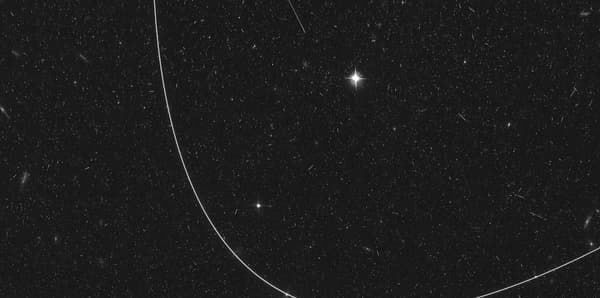A study published in the journal nature astronomy this Thursday warns of the dangers that hang over Hubble. Threatened by the proliferation of private satellites that orbit overhead, the photographs taken by the space telescope are increasingly contaminated, diminishing their scientific work.
Hubble, designed by NASA and the European Space Agency, was launched on April 24, 1990. Since then, it has made important discoveries -such as the confirmation of the existence of supermassive black holes- and has taken spectacular photographs, such as the ” Pillars of Creation”.
An increase in corrupted images in 2021
But an increasing part of the shots taken by the telescope are contaminated by thin white lines, or thick clouds that take up much of the frame. In question? The proliferation of private satellites that orbit above our heads, and that sometimes pass through Hubble’s field of view, revealed this Thursday the study published in nature astronomy.
The scientists analyzed a total of 100,000 images taken between 2002 and 2021 by Hubble. The results show that between 2009 and 2020, the risk of producing a contaminated image is 3.7%. But this percentage rises to 5.9% by 2021.
“With the increasing number of satellites currently planned, the proportion of Hubble Space Telescope images traversed by satellites will increase over the next decade,” the authors warn.
For now, the proportion of contaminated images remains limited. in the columns of New York Timesa NASA spokesperson said that “although such analyzes show an increase in satellite swarms over time, most of them are quickly removed and most images are still usable.”
Soon 431,713 satellites will be put into orbit
The authors of this Thursday’s study are less reassuring. In the preamble to their paper, they even go so far as to describe private satellites as “a growing threat to astronomical observations,” which could become “unusable for scientific research, wasting an increasing share of the research budget on expensive infrastructure.”
According to the figures of New York Times, 431,713 satellites will be put into orbit in the coming years. “We will live with this problem. And astronomy will be affected. Some studies will not be possible. Others will be much more expensive to carry out.” New York Times Jonathan McDowell, a Harvard astronomer and study member.

SpaceX, the space company owned by billionaire Elon Musk, is directly pointed out in this Thursday’s study to explain the increase in anomalies observed in 2021. On January 26, it returned to orbit 56 new satellites, the fifth mission of this type since the beginning of the year.
SpaceX Featured
These launches aim to strengthen the company’s broadband internet coverage, which already has 3,773 satellites. SpaceX has also indicated that “thousands” of other satellites would be sent in the “next few years.”
As early as May 2019, the scientific community was shocked by these satellite launches by private companies, fearing that they would disturb their observations of space. In a tweet, Elon Musk responded at the time that “we have to get the telescopes into orbit anyway.”
But Hubble, whose image quality is affected by private satellites, is already in orbit. In the future, the only solution left available to astronomers is to send their telescopes even further into space, beyond private satellites. HE New York Times remember, however, that the telescopes currently being developed are not going in that direction.
Source: BFM TV

